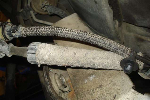It's not really water. It's a fluid (mostly comprised of sulfuric acid), and it's technically called an electrolyte. In a lead-acid car battery, the lead plates inside the battery are immersed in electrolyte fluid. As the battery cycles through discharge and charge cycles, the electrolyte evaporates and needs to be replaced by adding distilled water to the battery to keep the lead plates fully immersed. If the plates are allowed to run dry, the battery will fail.
Checking the electrolyte level is among the most ignored maintenance tasks. In fact, I believe the Explorer owners guide says that the factory batteries are "maintenance-free" and need no attention. This is not true. The Explorer batteries have removable caps to enable the electrolyte level to be checked, and if the level is low you can add distilled water to replenish the electrolyte.
But be careful! You're dealing with powerful sulfuric acid inside the battery, and you should wear safety glasses and gloves when you check the electrolyte level. Also, don't get even a single drop of electrolyte on your clothes. It will eat a hole through your clothing!










